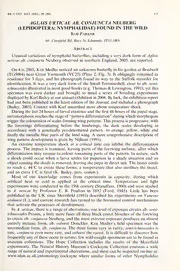
Aglais urticae ab. conjuncta Neuberg (Lepidoptera: Nymphalidae) found in the wild PDF
Preview Aglais urticae ab. conjuncta Neuberg (Lepidoptera: Nymphalidae) found in the wild
BR.J.ENT.NAT.HIST., 19:2006 57 AGLAIS URTICAE AB. CONJUNCTA NEUBERG (LEPIDOPTERA: NYMPHALIDAE) FOUND IN THE WILD Rob Parker 66, CornfieldRd, Bury St Edmunds, IP33 3BN Abstract Unusual variations ofnymphalid butterflies, including a very dark form ofAglais urticae ab. conjuncta Neuberg observed in southern England, 2005, are reported. On4.ix.2005, Ken Medlernoticed an unknown butterfly in his garden at Bradwell (TG5004) near Great Yarmouth (VC25) (Plate 2, Fig. 3). It obligingly remained in residence for 3 days, and his photograph found its way to the Suffolk recorder for identification. It was a very dark form ofthe Small Tortoiseshell, close to ab. semi- ichnusoidesillustratedinmostgood books (e.g. Thomas& Lewington, 1991), yet this specimen was even darker and brought to mind a series of breeding experiments displayedbyKarlBaileyatourannualexhibitionin2004. Byluck,theexhibitionreport hadjust been published in the latestedition ofthe Journal and included a photograph , (Bailey, 2005). Contact with Karl unearthed more about temperature shock. During the last24hours oflarval existence and the first48 hours ofthepupal stage, metamorphosisreachesthestageof“patterndifferentiation” duringwhichmorphogens triggerthecolourationofscalesformingwingpatterns.Thisprocessisprogressive,with the forewings differentiating before the hindwings, the dark scales developing in accordance with a genetically pre-determined pattern-to orange, yellow, white and finally the metallic blue parts ofthe hind wing. A more comprehensive description of wing pattern development is given by Nijhout (1991). An extreme temperature shock at a critical time can inhibit the differentiation process. The impact is transient, leaving parts of the forewing melanic, after which differentiation may resume to colour remainingparts ofthe pattern. In nature, such a shock could occur when a larva settles for pupation in a shady situation and an objectcausing the shade is removed, leaving the pupa in direct sun. The insect needs to reach c. 44°C to create these forms, a temperature that also sterilises the insect, and an extra 1°C is fatal (K. Bailey, pers. comm.). Most of our knowledge comes from experiments in captivity, during which artificial heat or cold is applied at the critical time. Temperature and light experiments were conducted in the 19th century (Standfuss, 1900) and were studied in A. urticae by Professor E. B. Poulton in 1892 (Ford, 1945). Little has been UK published in the since Merrifield (1893) described his experiments on Vanessa atalanta (L.), and current research has turned to the hormonal control mechanisms that activate the processes ofdevelopment. In A. urticae thereisa rangeofaberrations; onelevelofexposurecreatesab. semi- , ichnusoides Pronin, a little more fuses all three black costal blotches ofthe forewing to create ab. conjuncta Neuberg, and the most extreme exposure produces an almost entirely melanic form, ab. osborni Donckler. Ken Medler’s field specimen was the intermediate form, ab. conjuncta. The three forms vary in rarity; semi-ichnusoides is rare, conjuncta even more rare, and osborni the rarest. It is difficult to discover how frequentlyanyofthese occurin nature; fewwild-caught specimensareto befoundin museum collections. The Hope Collection includes the results of the Merrifield experiments. The Natural History Museum’s Cockayne Collection contains a wide range ofnatural and experimental aberrations, and thesecanbe inspected on-line at: www.nhm.ac.uk/entomology/cockayne where similar forms of other Nymphalidae 158 BR.J.ENT.NAT.HIST.,19:2006 may also be found. In addition, a number of the Argynninae, notably Argynnis aglaja L. can appear with heavy black suffusion along the lines of the veins. A selection of these partially differentiated melanic forms is illustrated in Emmet & Heath (1990). There is a subtle difference between the results of heat and cold. Specimens of A. urticae exposed to heat feature a series offine black lines along the veins at the outermarginoftheforewing(Plate2, Fig. 3), buttheselinesareabsentfromsubjectsof cold shock treatment. Experimentally, cold shock aberrations seemeasierto reproduce thanthosefollowingheat. Italsoseemsthattheeffectsoccurmorereadilyinspringand autumn, during the periods when daylight hours are changing most rapidly. Russwurm (1978) illustrates one wild-caught ab. conjuncta from Ringwood, Hants, 30.ix.1947. Since heat shock also renders the butterflies sterile, each example is a one-off, and not a genetic strain. Given the millions ofA. urticae over the years, it seems fair tojudge these aberrations genuinely rare in the wild. Two Suffolk sightings of the rather less rare aberration semi-ichnusoides are on record. On 26.viii.1990, Jim Foster photographed one in his Stonham Aspal garden (Foster, 1991). In September 2003, Richard Stewart found one in his Ipswich garden (Stewart, 2004), although this butterfly remainedjust out ofphotographic range. Interestingly, at least three other aberrations of different species also put in appearances in 2005. In Bedfordshire, at Sharpenhoe Clappers on 4.vii.2005, Peter Glenister photographed an extremely melanic Argynnis aglaja ab. wimani Holmgren (unpublished). David Dennis had the amazing good fortune to find first V. atalanta ab. klemensiewiczi Schille and then P. c-album ab. reichstettensis Fettig in his Buckinghamshire garden within days of one another [(19.ix.2005 & 21.ix.2005- Dennis (2005) includesphotographs ofboth)]. Thesetwo wildinsectshad apparently pupated on the side ofa metal barn, and it seems conceivable that this could have subjected them to higher than ambient temperatures. Has any reader heard ofsuch aberrations created under similar conditions? The author thanks Karl Bailey for his patient guidance, and Ken Medler, for his consent to use the photograph. References Bailey, K.E.J. 2005, in 2004 Annual Exhibition. Brit. J. Ent. Nat. Hist. 18: 171. Dennis, D. 2005. Weirdos at the bottom of my garden. Upper Thames Branch Butterfly Conservation October2005 Newsletter. Emmet,A.M.&Heath,J. 1990. TheMothsandButterfliesofGreatBritainandIreland,Yol.7(1) Hesperiidae-Nymphalidae. Harley Books. Ford, E.B. 1945. Butterflies Collins, London. , Foster, J.A. 1991. Aberrant Small Tortoiseshell. Transactions ofthe Suffolk Natural History Society 27: 40 & plate 8. Merrifield, F. 1893. The effects oftemperature in the pupal stage on the colouring ofPieris napi, Vanessa atalanta Chrysophanusphlaeas, and Ephyrapunctaria. Transactions ofthe , RoyalEntomologicalSociety ofLondon 41: 55-67. Nijhout, H.F. 1991. The Development andEvolution ofButterfly Wing Patterns. Smithsonian Institution Press, Washington. Russwurm, A.D.A. 1978. Aberrations ofBritish Butterflies. Classey, Farringdon. Standfuss, M. 1900. Synopsis of experiments in hybridisation and temperature made with lepidoptera up to the end of 1898. Entomologist34: 75-84. Stewart, R.G. 2004. The Small Tortoiseshell ab. semi-ichnusoides\ a Suffolk sighting. Transactions ofthe Suffolk Naturalists’Society40: 110. Thomas J. & Lewington, R. 1991. The Butterflies ofBritain & Ireland. Dorling Kindersley.
